Deja vu all over again: the "other" as trail user
The Gazette (via Greater Greater Washington and Washcycle) reports on anti-recreation trail sentiment in Prince George's County, including--horrors--having the trail run on "private" property through easements. See "‘We just don't want them in our backyards'."
In the project I am working on to create a pedestrian and bicycling master plan for part of a county in Maryland, I've come to see the necessity of having, if possible, a comprehensive plan for recreational trails. (As part of a comprehensive pedestrian and bicycle plan.)
For years, I've been freely expressing my biases in favor of street riding as opposed to separated riding on trails, and my bias towards transportation/utilitarian bicycling as opposed to recreational riding.
But guess what, planning isn't about your biases, it's about being expansive, thorough, complete, and structured--it's about serving everyone, not just people like yourself.
I've come to learn that many cities across the country have extensive recreational trail programs to accommodate both bicycling and walking. There are many great resources for trail planning (National Trails Training Partnership). And of course, on the East Coast, one of the augurs of trail development is the East Coast Greenway project, which works to provide a bicycle route along the East Coast somewhat comparable to the hiking route, the Appalachian Trail.
And yes, you can mix trails and transit.

Light rail in Barcelona. Photo by John Norquist.
Even the DC Parks "plan" (more about that later), Capital Space, proposes as part of one of its six "big ideas" that a greenway trail be created as part of the development of the Fort Circle Parks series of circle parks around the city. Plus there is the Anacostia Trail under development as well as the Metropolitan Branch Trail.
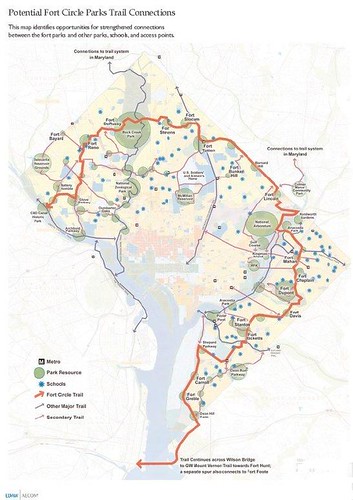
And the city has begun to place signage on the interim segments of the Metropolitan Branch Trail.
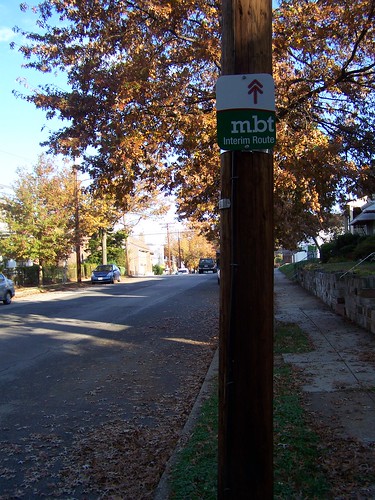
However, as Suzanne pointed out, the signs only communicate to people who already know about the trail and/or bicycling. They do nothing for people unfamiliar with the trail. MBT? To me, having been born in Michigan, when I see the acronym MBT, I think "Michigan Bell Telephone." Spell it out...
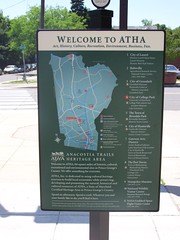
Anacostia Trail Heritage Areas wayfinding map sign.
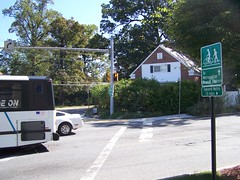
Trail signage in Montgomery County depicts images of cyclists and walkers, better communicating the purpose of the trail, compared to the equivalent signs in DC.
Wayfinding systems for bicycling and walking are very important. There is a good plan for wayfinding for the Bethesda Trolley Trail that can be used as a model to guide similar efforts elsewhere. And the Feet First organization in Seattle has developed amazing maps for neighborhoods, walk to school, and trails and districts.
And Baltimore is developing a number of trails (Gwynns Falls, Jones Falls, others), while in Montgomery County and Prince George's County, there is an integrated set of recreational trails already extant including the Northwest and Northeast Branch Trails, Sligo Creek, Capital Crescent, etc.
Prince George's County has a great brochure on the Anacostia River Tributaries recreational system, including trails, etc.
In talking with a colleague who used to work for the Chicago Bicycle Federation, we've both come to agree that for families, recreational trails are often the entrypoint for reintroducing bicycling as a accepted means for mobility, and as a way to practice and get comfortable with biking before going out to the roads.
This is the flip side of the point made in the Tyee article, "Portland's Bicycle Brilliance," that you have to find ways to make bicycling comfortable and safe for the 59% of people who are willing to ride transportationally, but aren't ready to mix with serious traffic.
And I have to say, riding on the streets defensively, always on the lookout to avoid dangerous situations with vehicles, is stressful. There is something to be said for riding on trails and not worrying about cars.
But you get this attitude that ‘We just don't want them in our backyards', which we have discussed before ("Criminal Bicyclists").
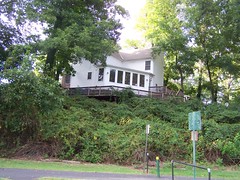
This house immediately abuts a small park and the Northwest Branch Trail in Prince George's County. I intend to go knock on their door at some point and interview them about these kinds of issues.
The basic idea behind the attitude is that anyone different from you (someone who doesn't drive a car--that means transit users, bicyclists, and walkers), especially from outside of your neighborhood, is to be feared and demonized as "the other," someone "not from around here" and likely to vandalize your property, break into your house, etc.
-- The Other as a philosophical concept.
The funny thing is that trails can be a great economic development tool (see the meta study of economic impact of trails from Rails to Trails Conservancy) and so many communities promote trails, recreational cycling, and cycle touring as an economic development initiative and an integral part of tourism promotion planning (Carroll County Maryland, Great Delmarva Bicycle Trail on the Eastern Shore of Maryland and Virginia, as well as Delaware, Caroline County Maryland, and the report Trail Towns: Capturing Trail-Based Tourism).
But at the same time, they are well focused on the provision of trails and greenways as an integral element of placemaking and quality of life for residents, investors, and visitors.
The reality is that crime on trails is not an issue generally, when compared to typical crime statistics. Although lightly used trails, or dark trails at night (see "Darkened Part of Park Trail Near Metro to Get Lighting" from the Post about crime problems on the Northwest Branch Trail in the vicinity of the West Hyattsville Metro Station--the area has had problems because it is in a relatively isolated location with limited "natural surveillance"--eyes on the street!) can be a problem.
The issue is to design trails right from the outset. For example, DDOT has done a great job by including lighting on the Metropolitan Branch Trail in areas abutting the railroad tracks and less traveled industrial areas. (I don't have photos yet.)
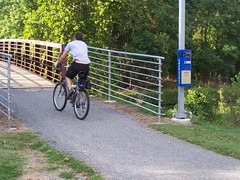
In the West Hyattsville area, emergency phones have been installed in some places on the Northwest Branch Trail.
All communities should have a trails network, if possible, to link parks and neighborhoods. The problem is that retrofitting such a system is very expensive. And that doesn't even get into the fear of the other questions. And for the most part, best practices parks and recreation planning includes trail planning.
Still, like for most park assets, living by trails ends up increasing residential property values (see the report by Professor John Crompton, The Proximate Principle: The Impact of Parks, Open Space and Water Features on Residential Property Values and the Property Tax Base).
In the case of the Baltimore and Annapolis Trail among others, has helped augur commercial district and neighborhood revitalization in places like Severna Park, Maryland, and they are incredible opportunities for volunteerism and civic engagement.
But as long as we focus on the other, the more we try to keep our neighborhoods isolated, the reality is that the more isolated--and less safe--we become.
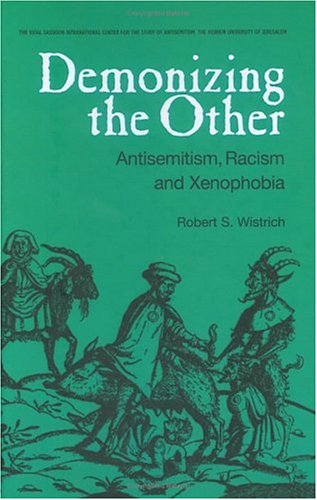
Labels: bicycling, civic engagement, parks and open space, provision of public services, transportation planning, walking, wayfinding



0 Comments:
Post a Comment
<< Home